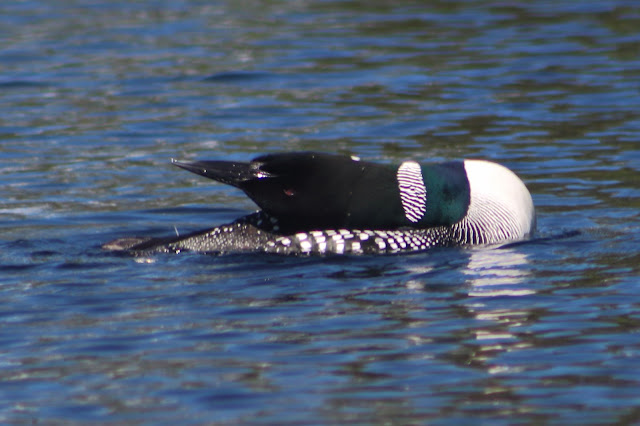You may have noticed the past week or two that some lush, vibrant green plants have shot up all around New Hampshire, particularly along roadsides.
 |
| Japanese Knotweed is four feet high after just a few weeks of growth |
Unfortunately, this is not a desirable species. Japanese Knotweed is one of the most aggressive of all the invasive species in New Hampshire; it is extremely fast-growing and spreads quickly, crowding out any other plants in its way. Here it is in the process of taking over this meadow along Camp Waldron Road (just past the junction with Chemung road) in Meredith.
Right across the street it has invaded a decades-old stand of Purple Lilac and within another year or two it will completely obliterate, and soon after kill those majestic shrubs. Once a patch reaches this magnitude it is very difficult to control, let alone exterminate it, and it happens so rapidly that they can take over an entire property in just a few years.
If you notice small growths you can attack them rather easily, it just requires a little persistence. They may look impressive but their stalks are hollow and very soft. The best approach is to cut them down when they reach a height of 4 or 5 feet, leaving the stalks on the ground (transporting them can spread them to other locations). When they grow back - and they will - cut them again. Then in late summer when they grow back yet again, spray them with the herbicide
Rodeo. Rodeo is preferred, but you can use Roundup if you are far from any water sources. (Do not use Roundup near any bodies of water.) Yes, I hate using this powerful, still not fully understood herbicide, but sometimes it is the best option.
Another approach which has less environmental impact is to apply full concentration of the herbicide directly to the stump of the stalks immediately after cutting them the last time - this prevents overspray and ensures the chemical goes only where needed. In either case it is best to do this late in the summer after the repeated cutting has weakened it, and the plant is in the phase of drawing nutrients, and thus the poison, down into the roots to store energy for winter.
At the very least, do not let them flower! If you do nothing more than cut them back repeatedly before they flower you will keep them from spreading and over time may kill them. You can find more detailed information on the
control of knotweed here.
With that sad story said, let's look to more enjoyable plants. Lady's Slippers are blooming throughout the woodlands now and I found the largest single clump of these pretty orchids I've ever seen when I was walking in the Sherman Easement at Meredith's Page Pond and Forest.
 |
| Pink Lady's Slipper |
Adding to the artwork on the forest floor is a whole host of tiny white flowers including starflower, bluets, bunchberry, goldthread, and lily of the valley.
 |
| Lily of the Valley (Convallaria majalis) |
Lily of the valley are indicative of human presence as they are not indigenous to New England (they are native to Europe and Asia) and though they also spread out they are not considered invasive. All parts of this plant are highly poisonous to humans and pets.
Higher up, the maples are dangling enticing touches of color into the picture.
 |
| Red maple have many different ways to color the forest though out the year |
Soon the chipmunks will be collecting these seeds for their winter stores.
You know the age-old question "Does a bear you-know-what in the woods?" Well, it appears this one does its thing right in the middle of the trail, on an outcropping of granite.
 |
| Bear scat left as a notice to all others in the forest |
A rotten birch log torn apart by some carnivore looking for ants, grubs, and other protein-rich delicacies may also be a sign of bears.
 |
| A rotten birch log was searched for insects |
Lying under rotten logs one will often find these little amphibians, which a bear would be happy to gobble up as well:
 |
| Red Backed Salamander (Plethodon cinereus) |
There has been much news of bears interacting with humans recently, including one
killed in Bristol and
three juviniles relocated to the north country, reminding us of the importance of taking down bird feeders and properly storing trash.
While you are out enjoying the sights be careful to watch for poison ivy as it is growing now and might not be noticed when it is small and just starting to get its shiny leaves.
 |
| The new year's crop of poison ivy is growing |
It loves to grow on disturbed, sunny, sandy locations including road edges.
 |
| Poison Ivy grows well along road edges |
So watch out for it when you attack that knotweed - did you notice it growing under the knotweed in the first picture in this post?
A quick update on the loons: The town is doing a great job managing the water level, and with the boards out of the dam Lake Wicwas is dropping quickly. Barring another deluge it should be at a good nesting level in another day or two. Stay tuned.

















































